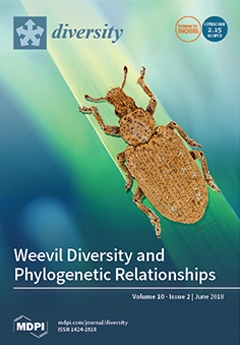The rate of establishment of non-native bark beetle species is accelerating in many parts of the world and is considered a serious threat to forests and forest crops. Distributional data for exotic bark beetles are urgently needed, but they must be based on sound taxonomy. Using primary literature and original records, I review for the first time the invasive bark beetle (Scolytinae) species in Chile and Argentina, and I give a short risk assessment for each. I also provide the best sources for identifying these species. The invasive pine bark beetle commonly referred to in Chilean research as
Orthotomicus erosus (Wollaston) is not that species: evidence suggests that the only
Orthotomicus that is or has been in Chile is
O. laricis (Fabricius), which is also the
Orthotomicus species reported in the most recent research from Argentina. I add new information on the distributions of two other abundant pine-breeding invasive species,
Hylurgus ligniperda (F.) and
Hylastes ater (Paykull), and I report that populations of
Hylastes linearis Erichson have been found in Chile. This is the first known occurrence of the species in South America.
Phloeotribus willei Schedl, a tiny bark beetle collected from domestic fig trees in Chile and Peru, has been considered native heretofore. I argue that it must be an introduced Neotropical species, and I present new localities for Chile. I present the first Chilean records of the Myrtaceae specialist ambrosia beetle
Amasa truncata (Erichson), an Australian species recently found in southern Brazil and northeastern Uruguay, and new Argentinian records that seem to be the earliest finds of
Xylosandrus crassiusculus (Motschulsky) in South America. The Canary Island palm seed specialist
Dactylotrypes longicollis (Wollaston) is reported for the first time from South America, from Chile. The presence in Chile of another spermatophage,
Coccotrypes dactyliperda (F.), is confirmed. New Chilean regions and new host records are given for
Pagiocerus frontalis (F.), a species that breeds in Lauraceae seeds but also in stored maize. Other exotic species treated briefly include
Hylastinus obscurus (Marsham),
Hylesinus taranio (Danthione),
Scolytus multistriatus (Marsham),
S. rugulosus (Müller),
Coccotrypes cyperi (Beeson), and
Xyleborinus saxeseni (Ratzeburg). Finally, reports of several species from Chile or Argentina are considered unsupported by evidence:
Scolytus kirschii Skalitzky,
Pityokteines curvidens (Germar),
Coccotrypes robustus Eichhoff, and
Hypothenemus hampei (Ferrari).
La velocidad de establecimiento de especies de coleópteros descortezadores no nativos se está acelerando en muchas partes del mundo y se considera una amenaza seria a bosques y cultivos forestales. Se requiere datos distribucionales urgentemente, pero estos tienen que basarse en taxonomía sólida. Utilizando literatura primaria y registros originales, reviso por primera vez la fauna invasora de especies de descortezadores (Scolytinae) en Chile y Argentina, y ofrezco una evaluación breve del riesgo de cada una. También proporciono los mejores referencias para identificar estas especies. La especie descortezador invasora de pinos comunmente citado en investigaciones chilenas como
Orthotomicus erosus (Wollaston) no es esa: la evidencia sugiere que la única especie de
Orthotomicus actualmente o históricamente presente en Chile es
O. laricis (Fabricius), la cual es la especie de
Orthotomicus reportado en las investigaciones mas recientes de Argentina. Agrego información nueva sobre las distribuciones de otros dos especies abundantes invasoras que se reproducen en pinos,
Hylurgus ligniperda (F.) y
Hylastes ater (Paykull) y comunico que poblaciones de
Hylastes linearis Erichson se han encontrado en Chile, siendo esta el primer hallazgo de la especie en Sudamérica.
Phloeotribus willei Schedl, una especie minúscula colectado de higueras cultivadas en Chile y Peru, se ha considerado nativa hasta ahora: presento argumentos que debe de ser una especie neotropical introducida y presento nuevas localidades para Chile. Presento los primeros registros chilenos de
Amasa truncata (Erichson) coleóptero ambrosial, especialista en Myrtaceae, especie australiana recientemente encontrada en el sur de Brasil y nordeste de Uruguay, y nuevos registros argentinos que parecen ser los primeros hallazgos de
Xylosandrus crassiusculus (Motschulsky) en Sudamérica. Se registra la especialista en semillas de palma,
Dactylotrypes longicollis (Wollaston), originario de las Islas Canárias pro primera vez de Sudamérica; se confirma la presencia en Chile de otra espermatófago,
Coccotrypes dactyliperda (F.)
. Se presentan nuevos registros regionales de Chile y de hospederas por
Pagiocerus frontalis (F.), especie que se reproduce en semillas de Lauraceae pero también en maíz almacenado. Otras especies exóticas tratadas brevemente incluyen
Hylastinus obscurus (Marsham),
Hylesinus taranio (Danthione),
Scolytus multistriatus (Marsham),
S. rugulosus (Müller),
Coccotrypes cyperi (Beeson), y
Xyleborinus saxeseni (Ratzeburg). Finalmente, registros de varias especies de Chile o de Argentina se consideran sin apoyo de evidencia:
Scolytus kirschii Skalitzky,
Pityokteines curvidens (Germar),
Coccotrypes robustus Eichhoff, y
Hypothenemus hampei (Ferrari).
Full article





